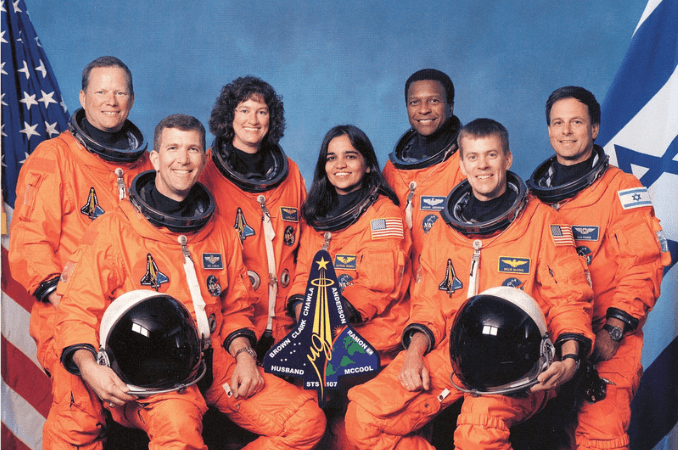Hello, friends! Gorick here.
Today’s story is a cautionary tale of why it’s so important to listen.
The takeaway: Reward the “whistleblowers” in your life
Otherwise, you’ll only get what you want to hear and not what you need to hear.
WHY?
NASA would not have lost 7 astronauts had its leaders listened.
You may have heard of the Columbia space shuttle disaster—the 2003 tragedy where the spacecraft broke apart upon reentry, killing all seven astronauts on board.
But did you know that engineers had raised concerns about the shuttle’s safety days before it returned to Earth?
It was January 2003, and NASA had just launched Columbia into space. Just 82 seconds after liftoff, a suitcase-sized chunk of foam insulation broke off the fuel tank and slammed into the shuttle’s left wing.
The next day, engineers reviewing launch footage noticed the strike. Rodney Rocha, chief structural engineer, asked for high-resolution images from military spy satellites to assess the damage. In memos, he warned of “grave hazards” and the risk of “catastrophic thermal damage” on reentry. One email even read: “Can we petition [beg] for outside agency assistance?”

Management declined the requests and did not treat the foam strike as a critical safety issue for several reasons. Foam shedding from the external tank had occurred on earlier missions without catastrophic results, and over time, it became regarded as an “accepted flight risk.”
Managers also concluded that the debris from Columbia likely did not have enough kinetic energy to cause dangerous damage, and a risk assessment from Boeing, the contractor supporting the shuttle program, included a slide that implied the danger was low, which influenced how NASA viewed the situation.
So they insisted that there was “no safety of flight issue.” Requests for satellite imagery of Columbia’s wing were either not pursued or blocked, in part due to procedural confusion and the prevailing belief that the situation did not pose an immediate threat. When engineers pushed, one manager asked, “Who’s requesting the photos?”—a sign the focus was on hierarchy, not the hazard.
For seventeen days, the concerns stayed at lower levels. The crew was told to expect only localized structural damage. No extra imagery was taken.
On February 1, as Columbia reentered the atmosphere, superheated air poured into the damaged wing. The shuttle disintegrated.
The investigation later confirmed the foam strike was the cause—but it also concluded that NASA’s culture made it dangerously easy to ignore inconvenient truths.
UNSPOKEN RULE
Reward the ‘whistleblowers’ in your life
At work, “whistleblowers” aren’t always uncovering corruption—they’re often the people who see risks before everyone else. It might be a junior analyst who spots a flaw in a spreadsheet, a project manager who notices a gap in the plan, or a frontline employee who catches a safety hazard.
The problem? Many leaders treat these people as troublemakers instead of as safeguards. And many of us surround ourselves with “yes” people who are more interested in making us feel good than in helping us succeed. That’s a mistake. When people stop flagging issues, it’s not because the issues have disappeared—it’s because the people around you have learned that it’s safer to stay silent.
To apply this rule:
- Acknowledge the courage. Even if their concern doesn’t turn into a real problem, thank them for raising it: “Thank you for letting me know. I know it may not be easy coming to me, but I really do appreciate you telling me what I need to hear instead of what I want to hear.”
- Act quickly and visibly. Show that you investigate and respond to potential risks instead of brushing them off: “I’m going to go ahead and [take this action / do this investigating] right away. Can I get your feedback once I’ve got more information to share?”
- Make it easy to speak up. Whether it’s by creating an anonymous suggestion box or simply getting into the habit of asking, “Tell me everything that’s wrong or that you don’t like about this,” people need to see a pattern of behavior that suggests that you care.
See you next Tuesday for our next story and unspoken rule!
—Gorick
Want me to answer your own career question?
Ask me here: https://forms.gorick.com/askgorick
What’s an “unspoken rule”? They’re the things that separate those who get ahead from those who stumble—and don’t know why. You can learn more about these rules in the workplace in my Wall Street Journal bestselling book called—you guessed it—The Unspoken Rules.
Every newsletter is free and a fraction of my work.
Here are 3 of my paid offerings that may interest you:
1. Keynote speaking: My 2025 calendar is filling up! If your organization is looking for speakers for graduation season, manager training, new hire / early career orientation, AAPI Heritage Month, ERG summits, or something else, let’s chat!
2. How to Say It: Flashcards that teach you to know what to say in every high-stakes professional setting via hundreds of fill-in-the-blank scripts (just like the examples above). Free shipping on all orders over $40.
3. The Unspoken Rules: My Wall Street Journal Bestseller that Arianna Huffington calls “a blueprint for anyone starting their career, entering a new role, or wanting to get unstuck.” Used by top companies and MBA programs.
Sources:
- Columbia space shuttle disaster
- a suitcase-sized chunk of foam insulation
- High-resolution images from military spy satellites to assess the damage
- “grave hazards” and the risk of “catastrophic thermal damage”
- “Can we petition [beg] for outside agency assistance?”
- it became regarded as an “accepted flight risk.”
- did not have enough kinetic energy to cause dangerous damage.
- risk assessment from Boeing
- There was “no safety of flight issue.”
- “Who’s requesting the photos?”
- The investigation later confirmed the foam strike was the cause
- Cover image
- The 7 crew of 2003 Columbia mission


